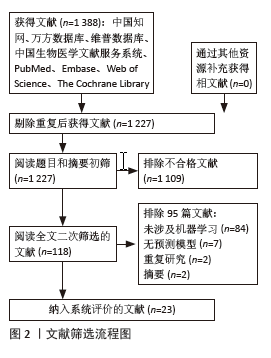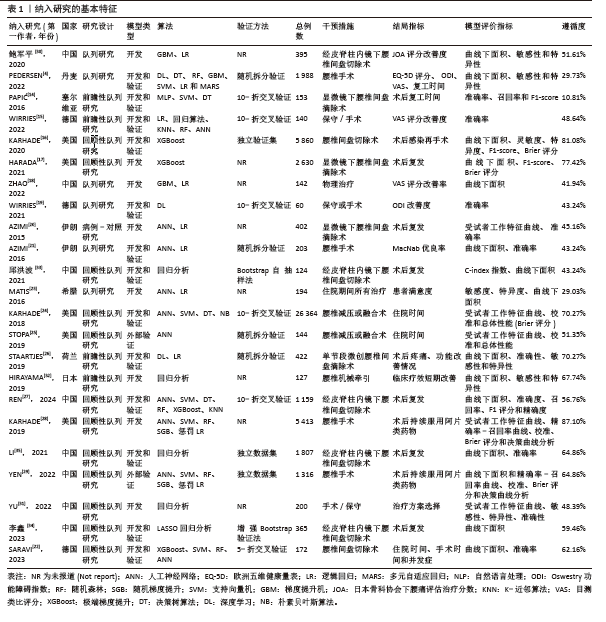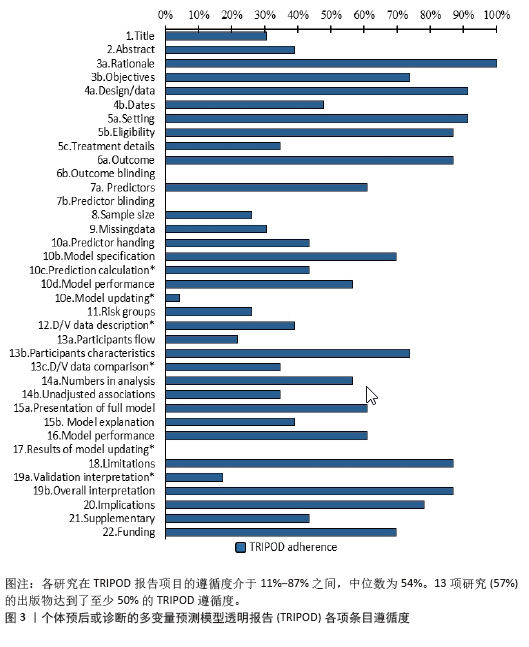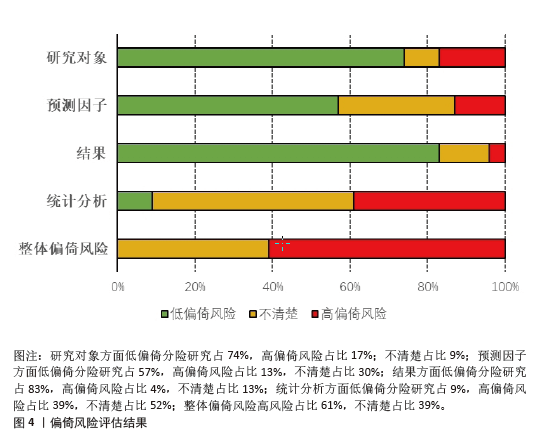[1] AMIN RM, ANDRADE NS, NEUMAN BJ. Lumbar Disc Herniation. Curr Rev Musculoskelet Med. 2017;10(4):507-516.
[2] DEYO RA, MIRZA SK. CLINICAL PRACTICE. Herniated Lumbar Intervertebral Disk. N Engl J Med. 2016;374(18):1763-1772.
[3] 王秀艳, 于希军. 中西医治疗腰椎间盘突出症研究进展[J].现代中西医结合杂志,2019, 28(10):1132-1136.
[4] PEDERSEN CF, ANDERSEN MØ, CARREON LY, et al. Applied Machine Learning for Spine Surgeons: Predicting Outcome for Patients Undergoing Treatment for Lumbar Disc Herniation Using PRO Data. Global Spine J. 2022;12(5):
866-876.
[5] YOO BR, SON S, LEE SG, et al. Factors Predicting the Clinical Outcome After Trans-sacral Epiduroscopic Laser Decompression for Lumbar Disc Herniation. Neurospine. 2021;18(2):336-343.
[6] BI Q, GOODMAN KE, KAMINSKY J, et al. What is machine learning? A primer for the epidemiologist. Am J Epidemiol. 2019;188: 2222-2239.
[7] OBERMEYER Z, EMANUEL EJ. Predicting the future - big data, machine learning, and clinical medicine. N Engl J Med. 2016; 375:1216-1219.
[8] MOONS KG, DE GROOT JA, BOUWMEESTER W, et al. Critical appraisal and data extraction for systematic reviews of prediction modelling studies: the CHARMS checklist. PLoS Med. 2014;11: e1001744.
[9] MOONS KG, ALTMAN DG, REITSMA JB, et al. Transparent reporting of a multivariable prediction model for individual prognosis or diagnosis (TRIPOD): explanation and elaboration. Ann Intern Med. 2015;162: W1-W73.
[10] COLLINS GS, REITSMA JB, ALTMAN DG, et al. Transparent reporting of a multivariable prediction model for individual prognosis or diagnosis (TRIPOD): the TRIPOD statement. Eur Urol. 2015;67:1142-1151.
[11] MOONS KGM, WOLFF RF, RILEY RD, et al. PROBAST: a tool to assess risk of bias and applicability of prediction model studies: explanation and elaboration. Ann Intern Med. 2019;170:W1-W33.
[12] WOLFF RF, MOONS KGM, RILEY RD, et al. PROBAST: A tool to assess the risk of bias and applicability of prediction model studies. Ann Intern Med. 2019;170(1): 51-58.
[13] 曹煜隆, 单娇, 龚志忠, 等.个体预后与诊断预测模型研究报告规范:TRIPOD声明解读[J]. 中国循证医学杂志, 2020,20(4):492-496.
[14] PAPIĆ M, BRDAR S, PAPIĆ V, et al. Return to Work After Lumbar Microdiscectomy - Personalizing Approach Through Predictive Modeling. Stud Health Technol Inform. 2016;224:181-183.
[15] WIRRIES A, GEIGER F, HAMMAD A, et al. AI Prediction of Neuropathic Pain after Lumbar Disc Herniation-Machine Learning Reveals Influencing Factors. Biomedicines. 2022;10(6): 1319.
[16] KARHADE AV, BONGERS MER, GROOT OQ, et al. Can natural language processing provide accurate, automated reporting of wound infection requiring reoperation after lumbar discectomy? Spine J. 2020;20(10): 1602-1609.
[17] HARADA GK, SIYAJI ZK, MALLOW GM, et al. Artificial intelligence predicts disk re-herniation following lumbar microdiscectomy: development of the “RAD” risk profile. Eur Spine J. 2021;30(8): 2167-2175.
[18] ZHAO P, XUE J, XU X, et al. Logistic Model and Gradient Boosting Machine Model for Physical Therapy of Lumbar Disc Herniation. Comput Math Methods Med. 2022;2022:4799248.
[19] WIRRIES A, GEIGER F, HAMMAD A, et al. Artificial intelligence facilitates decision-making in the treatment of lumbar disc herniations. Eur Spine J. 2021;30(8): 2176-2184.
[20] AZIMI P, MOHAMMADI HR, BENZEL EC, et al. Use of artificial neural networks to predict recurrent lumbar disk herniation. J Spinal Disord Tech. 2015;28(3):E161-E165.
[21] AZIMI P, BENZEL EC, SHAHZADI S, et al. The prediction of successful surgery outcome in lumbar disc herniation based on artificial neural networks. J Neurosurg Sci. 2016;60(2): 173-177.
[22] SARAVI B, ZINK A, ÜLKÜMEN S, et al. Clinical and radiomics feature-based outcome analysis in lumbar disc herniation surgery. BMC Musculoskelet Disord. 2023;24(1): 791.
[23] MATIS GK, CHRYSOU OI, SILVA D, et al. Prediction of Lumbar Disc Herniation Patients’ Satisfaction with the Aid of an Artificial Neural Network. Turk Neurosurg. 2016;26(2):253-259.
[24] KARHADE AV, OGINK P, THIO Q, et al. Development of machine learning algorithms for prediction of discharge disposition after elective inpatient surgery for lumbar degenerative disc disorders. Neurosurg Focus. 2018;45(5):E6.
[25] STOPA BM, ROBERTSON FC, KARHADE AV, et al. Predicting nonroutine discharge after elective spine surgery: external validation of machine learning algorithms. J Neurosurg Spine. 2019;26:1-6.
[26] STAARTJES VE, DE WISPELAERE MP, VANDERTOP WP, et al. Deep learning-based preoperative predictive analytics for patient-reported outcomes following lumbar discectomy: feasibility of center-specific modeling. Spine J. 2019;19(5):853-861.
[27] REN G, LIU L, ZHANG P, et al. Machine Learning Predicts Recurrent Lumbar Disc Herniation Following Percutaneous Endoscopic Lumbar Discectomy. Global Spine J. 2024;14(1):146-152.
[28] KARHADE AV, OGINK PT, THIO QCBS, et al. Development of machine learning algorithms for prediction of prolonged opioid prescription after surgery for lumbar disc herniation. Spine J. 2019;19(11):1764-1771.
[29] YEN HK, OGINK PT, HUANG CC, et al. A machine learning algorithm for predicting prolonged postoperative opioid prescription after lumbar disc herniation surgery. An external validation study using 1,316 patients from a Taiwanese cohort. Spine J. 2022; 22(7):1119-1130.
[30] 鲍军平, 刘磊, 时睿, 等. 梯度提升机模型对腰椎间盘突出症经皮内镜切除术近期疗效的预测作用[J]. 中华骨科杂志, 2020,40(19): 1327-1336.
[31] YU G, YANG W, ZHANG J, et al. Application of a nomogram to radiomics labels in the treatment prediction scheme for lumbar disc herniation. BMC Med Imaging. 2022; 22(1):51.
[32] HIRAYAMA K, TSUSHIMA E, ARIHARA H, et al. Developing a clinical prediction rule to identify patients with lumbar disc herniation who demonstrate short-term improvement with mechanical lumbar traction. Phys Ther Res. 2019;22(1): 9-16.
[33] 邱洪波, 唐乐, 何甜, 等. 椎间孔镜治疗腰椎间盘突出症患者术后复发的个体化预警模型的建立[J].西安交通大学学报(医学版),2021,42(6): 817-822.
[34] 李鑫, 罗鸣然, 李根, 等. 建立与验证经皮内窥镜腰椎间盘切除后复发风险的预测模型[J].中国组织工程研究,2023, 27(13):2087-2092.
[35] LI Y, WANG B, LI H, et al. Adjuvant surgical decision-making system for lumbar intervertebral disc herniation after percutaneous endoscopic lumber discectomy: a retrospective nonlinear multiple logistic regression prediction model based on a large sample. Spine J. 2021;21(12):2035-2048.
[36] 陈香萍, 张奕, 庄一渝, 等. PROBAST:诊断或预后多因素预测模型研究偏倚风险的评估工具[J].中国循证医学杂志, 2020,20(6): 737-744.
[37] ANDAUR NAVARRO CL, DAMEN JAA, TAKADA T, et al. Risk of bias in studies on prediction models developed using supervised machine learning techniques: systematic review. BMJ. 2021;375:n2281.
[38] HALLER MC, ASCHAUER C, WALLISCH C, et al. Prediction models for living organ transplantation are poorly developed, reported, and validated: a systematic review. J Clin Epidemiol. 2022;145: 126-135.
[39] MULDER FI, CANDELORO M, KAMPHUISEN PW, et al. The Khorana score for prediction of venous thromboembolism in cancer patients: a systematic review and meta-analysis. Haematologica. 2019; 104(6):1277-1287.
[40] COLLINS GS, OGUNDIMU EO, ALTMAN DG. Sample size considerations for the external validation of a multivariable prognostic model: a resampling study. Stat Med. 2016; 35(2):214-226.
[41] ZHOU ZR, WANG WW, LI Y, et al. In-depth mining of clinical data: the construction of clinical prediction model with R. Ann Transl Med. 2019;7(23):796.
[42] STEKHOVEN DJ, BÜHLMANN P. MissForest--non-parametric missing value imputation for mixed-type data. Bioinformatics. 2012; 28(1):112-118.
[43] HARIBHAKTI N, AGARWAL P, VIDA J, et al. A simple scoring tool to predict medical intensive care unit readmissions based on both patient and process factors. J Gen Intern Med. 2021; 36(4):901-907.
[44] STEYERBERG EW, HARRELL FE. Prediction models need appropriate internal, internal-external, and external validation. J Clin Epidemiol. 2016;69:245-247.
[45] MOONS KG, KENGNE AP, WOODWARD M, et al. Risk prediction models: I. Development, internal validation, and assessing the incremental value of a new (bio)marker. Heart. 2012;98(9):683-690.
[46] COLLINS GS, MOONS KGM. Reporting of artificial intelligence prediction models. Lancet. 2019;393:1577-1579.
[47] COLLINS GS, DHIMAN P, ANDAUR NAVARRO CL, et al. Protocol for development of a reporting guideline (TRIPOD-AI) and risk of bias tool (PROBAST-AI) for diagnostic and prognostic prediction model studies based on artificial intelligence. BMJ Open. 2021;11:e048008.
|



